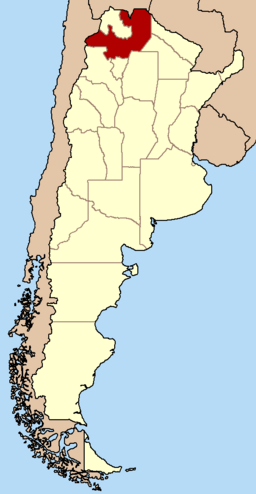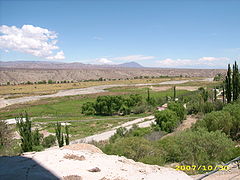Salta Province
| Salta | |||
| Province | |||
|
|||
| Divisions | 23 departments | ||
|---|---|---|---|
| Capital | Salta | ||
| Area | 155,488 km² (60,034 sq mi) | ||
| Population | 1,079,051 (2001) | ||
| Density | 6.94 /km² (18 /sq mi) | ||
| Governor | Juan Manuel Urtubey | ||
| - Senators | Juan Carlos Romero, Juan Perez Alsina, Sonia Escudero | ||
| ISO 3166-2 code | AR-A | ||
| Demonym | Salteño | ||
 |
|||
| Website: http://www.salta.gov.ar | |||
Salta is a province of Argentina, located in the northwest of the country. Neighboring provinces are from the east clockwise Formosa, Chaco, Santiago del Estero, Tucumán and Catamarca. It also surrounds Jujuy. To the north it borders Bolivia and Paraguay and to the west lies Chile.
Contents |
History
Before the arrival of the Spanish conquest, numerous native people (now called Diaguitas and Calchaquíes) lived in the valleys of what is now Salta Province; they formed many different tribes, the Quilmes and Humahuacas among them, which all shared the Cacán language. The Atacamas lived in the Puna, and the Wichís (Matacos), near Chaco Province.
The first conquistador to venture into the area was Diego de Almagro, in 1535; he was followed by Diego de Rojas. Hernando de Lerma founded San Felipe de Lerma in 1582, following orders of the viceroy Francisco de Toledo, Count of Oropesa; the name of the city was soon changed to "San Felipe de Salta". By 1650, the city had around five hundred inhabitants.
An intendency of "Salta del Tucumán" was created within the Viceroyalty of the Río de la Plata. In 1774, San Ramón de La Nueva Orán was founded between Salta and Tarija (Tarija was added to the intendency later, in 1807). In 1783, in recognition of the growing importance of the city, the capital of the intendency of Salta del Tucumán was moved from Tucumán to Salta.
The battle of Salta in 1813 freed the territory from Spain, but occasional attacks were mounted from the Viceroyalty of Peru as late as 1826. Gervasio de Posadas created the Province of Salta in 1814; it covered the current provinces of Salta, Jujuy, and parts of southern Bolivia and northern Chile.
Exploiting internal Argentine conflicts that arose after the Argentine Declaration of Independence, Bolivia annexed Tarija in 1826. In 1834, Jujuy withdrew from Salta and became a separate province. The borders of Salta were reduced further in 1900, with the loss of Yacuiba to Bolivia.
The National Government of Los Andes, constituted from the province in 1902 with a capital at San Antonio de Los Cobres, was returned to Salta Province in 1943 as the Department of Los Andes.
Geography and climate
To the West, the Puna's arid high plains with salty lakes (Arizaro, Pocitos) has few inhabitants, and its main city is San Antonio de los Cobres.
High snowy Andean peaks (Acay, Cachi and Chañi) lower to the North-east and hold valleys such as Quebrada del Toro, Valles Calchaquíes and the Lerma Valley. This is the most densely inhabited area, and where the Salta city is found. The climate of the area is of hot summers (average of 23 °C with peaks of 40 °C) and cold winters with temperatures well below freezing point.
To the east, near the Gran Chaco area, the more humid subtropical climate is home to the Yungas jungle in the El Rey National Park.
The main rivers of the province are the Pilcomayo, Bermejo and the Juramento, which later becomes the Salado River. Salta Province is located at a geologically active region, and suffers from occasional earthquakes. Fairly destructive were the ones that occurred in 1692 and 1948.
Economy
Salta's economy is relatively underdeveloped, yet diverse. Its economy in 2006 was estimated at US$5.1 billion, or, US$4,760 per capita (over 45% below the national average).[1]
Agriculture and its derived industries are still an important activity in the province, adding over 10% to output. Tobacco, sugar cane and viticulture are the most important and produce most of the exports from the area. Other crops mostly for local consumption are maize, beans, citrus, bananas, and tomatoes. The sugar cane is processed in plants in Salta before it is sent to the rest of Argentina and other countries. The plant in San Martín de Tabacal is the most important of them. The famous wines of the Valles Calchaquíes region near Cafayate are produced in numerous vineyards of diverse sizes (mainly Torrontés, Malbec and Cabernet Sauvignon).
Gas and petroleum from the Tartagal, Aguas Blancas, Madrejones and Campo Durán centres is transported to Buenos Aires and Rosario by pipes. Campo Durán also has an oil refinery located in the province. In all, manufacturing plays a significant role in Salta, adding 20% to the economy. Mining includes sulfur extraction at the La Casualidad mine, and uranium at Iruya, La Poma and San Carlos.
American breeds of cattle are raised only on the humid sub-tropical east, along with some sheep and goats.
Tourism
The Salta Province is home to a number of natural, social and historic attractions.
The city of Salta "La Linda" ("The beautiful") is both an important tourist destination, and the centre point for visiting the rest of the province. The city holds different attractions; among them are her colonial houses and cathedral, and the Museo de Arqueología de Alta Montaña de Salta that holds the 3 frozen Inca mummies found at the 6,700 meters of the Llullaillaco volcano.

Also from Salta, the Tren a las nubes crosses canyons and cliffs before arriving to the 3,775 metres (12,500 feet) of San Antonio de los Cobres. The red-rock formations of the Valles Calchaquíes and the wine-town of Cafayate are the second most visited place in the province. Many visit the Cachi mountain and the villages (such as Payogasta) around it.
There are 3 national parks in Salta: El Rey National Park in the Yungas jungle, Baritú National Park and Los Cardones National Park.
Political division
The province is divided in 23 departments (Spanish: departamentos). Department (Capital)
- Anta (Joaquín Víctor González)
- Cachi (Cachi)
- Cafayate (Cafayate)
- Capital (Salta)
- Cerrillos (Cerrillos)
- Chicoana (Chicoana)
- General Güemes (General Güemes)
- General San Martín (Tartagal)
- Guachipas (Guachipas)
- Iruya (Iruya)
- La Poma (La Poma)
- La Caldera (La Caldera)
- La Candelaria (La Candelaria)
- La Viña (La Viña)
- Los Andes (San Antonio de los Cobres)
- Metán (San José de Metán)
- Molinos (Molinos)
- Orán (San Ramón de la Nueva Orán)
- Rivadavia (Rivadavia)
- Rosario de la Frontera (Rosario de la Frontera)
- Rosario de Lerma (Rosario de Lerma)
- San Carlos (San Carlos)
- Santa Victoria (Santa Victoria)
See also
- 1948 Salta earthquake
References
External links
- Official Page (Spanish)
- Tourist Secretary (Spanish)
- Salta (Spanish)
- Nuevo Diario de Salta (Spanish)
- Universidad Nacional de Salta (Spanish)
- Welcome Salta
|
||||||||||

